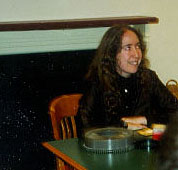 When I saw what Erica Baum was doing with photography a few years ago, I knew that it was closely related to what I was trying to teach my students about modern and contemporary poetry, so I invited Erica to visit us at the Writers House. It was a great visit.
When I saw what Erica Baum was doing with photography a few years ago, I knew that it was closely related to what I was trying to teach my students about modern and contemporary poetry, so I invited Erica to visit us at the Writers House. It was a great visit.Her photographic art captures only alphabetically related terms and puts them into new context. Her photographs are archaic storage systems of knowledge yielding randomly found commentaries, creating landscapes of words, as "subject headings" appear over the vistas of information sheets formed by unexposed cards in card catalogue drawers. How much a particular set of words is revealed, by the angle of the shot, is the essence of Baum's humor. "The self-consciousness" entailed in the act of cataloguing the catalogue, wrote Christopher Chamgers in NY Arts (9/13/97), "intimates the transcience and fragility of human accomplishments. It is our learning that makes the endless concatenation of teaching ironic."
In Baum's art, "the act of information retrieval is turned into a journey," writes Josefine Raab, "--of seemingly unknown destination." Baum will produce a picture of related terms (words and phrases) in alphabetical order, so that for instance the term "Subversive Activities" will appear next to "Suburban Homes" (from Untitled [Suburban], 1997, gelatin silver print, 20x24 inches, shown at Clementine Gallery, New York). The result is what Alice Thorson sees as "a form of found minimalist poetry." Words photographed from an index are lineated like poetry, for example:
rain
cause of, 59-63
what to do when lost in, 185-186
 Baum's photographs of such index fragments appear to have been taken from grainy and enlarged photocopies, a setp that engages them in a dialogue with abstract painting while also invoking the pervasiveness of technology.
Baum's photographs of such index fragments appear to have been taken from grainy and enlarged photocopies, a setp that engages them in a dialogue with abstract painting while also invoking the pervasiveness of technology.Baum exposes a Dadaist absurdity perhaps closer to Fluxus puns than to Duchampian metaphysics. Textual without becoming didactic, Baum's linguistic play is informed by the poetics of our era.
"Fragments of an index," Baum writes (in a statement dated April 2000), "reveal the unexpected fictions, rhythms and poetry hidden with a book's internal system of reference... A tension is created between what is absent, the book, and what is present, the concatenation of sounds and meanings wrenched from their source...."
Here's more.






 "I teach horizontally, meaning that while I might begin with a fixed idea of what I'm going to teach that day, I let it drift rhizomatically way off topic, often pulling it back when it gets too far. I rely on non-fixed materials to teach this way; the whole world is at my fingertips. Should I go off on a tangent about John and Rauschenberg and their love relationship as expressed in Rauschenberg's bed, an image of that bed is always a click away. From there, we can head anywhere into the non-fixed universe, be it film, text or sound. And of course, that always takes us elsewhere. As Cage says, 'We are getting nowhere fast.'"
"I teach horizontally, meaning that while I might begin with a fixed idea of what I'm going to teach that day, I let it drift rhizomatically way off topic, often pulling it back when it gets too far. I rely on non-fixed materials to teach this way; the whole world is at my fingertips. Should I go off on a tangent about John and Rauschenberg and their love relationship as expressed in Rauschenberg's bed, an image of that bed is always a click away. From there, we can head anywhere into the non-fixed universe, be it film, text or sound. And of course, that always takes us elsewhere. As Cage says, 'We are getting nowhere fast.'" 

 that anyone has yet got the imaginative measure of that terrifying day six years ago. Certainly our Tolstoy has not crawled out of the rubble. The closest we have, Don DeLillo, succeeded as an essayist-journalist ("In the Ruins of the Future: Reflections on Terror and Loss in the Shadow of September,” Harper’s, December 2001) but, to my mind, failed as a novelist ("Falling Man"). One reason, perhaps, is that the remembered emotion was instantly buried under a pile of cultural junk.' - Tod Gitlin in his review of Susan Faludi's The Terror Dream (written for
that anyone has yet got the imaginative measure of that terrifying day six years ago. Certainly our Tolstoy has not crawled out of the rubble. The closest we have, Don DeLillo, succeeded as an essayist-journalist ("In the Ruins of the Future: Reflections on Terror and Loss in the Shadow of September,” Harper’s, December 2001) but, to my mind, failed as a novelist ("Falling Man"). One reason, perhaps, is that the remembered emotion was instantly buried under a pile of cultural junk.' - Tod Gitlin in his review of Susan Faludi's The Terror Dream (written for 






























